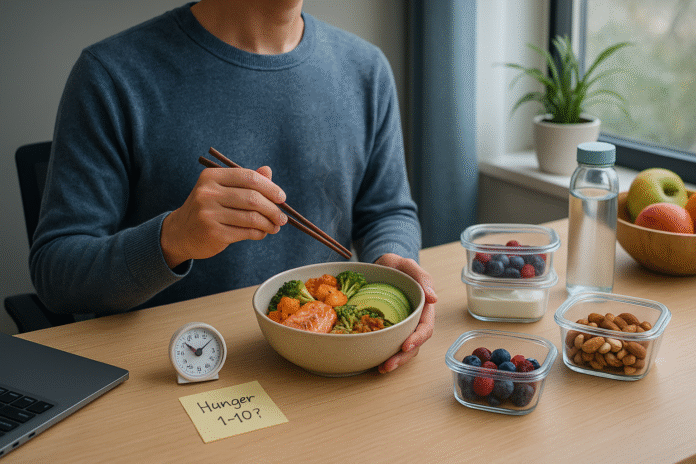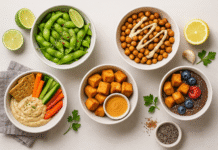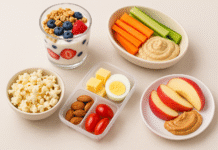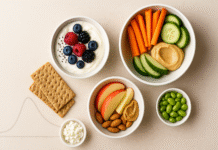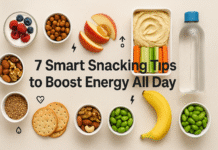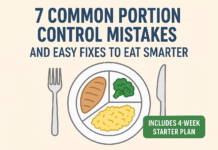If back-to-back meetings have turned lunch into a desk-side afterthought, you’re not alone. Many busy professionals want to eat well but feel pressed for time, pulled by screens, and stuck in “grab-and-go” patterns. Mindful eating is a practical, evidence-informed way to reclaim meals—even on hectic days—by training attention, tuning into hunger and fullness cues, and designing an environment that supports better choices. In this guide, you’ll learn five high-impact habits you can start today, plus how to troubleshoot common pitfalls, measure progress, and follow a simple four-week plan to make mindful eating stick. (This article offers general education, not medical advice. If you have a medical condition, food allergies, or special nutrition needs, consult a qualified clinician or registered dietitian.)
Key takeaways
- Protect one device-free, 20-minute meal a day to improve awareness, enjoyment, and satisfaction.
- Check in with a simple hunger–fullness scale before, during, and after you eat to calibrate portions in real time.
- Pre-portion meals and snacks ahead of time to sidestep decision fatigue and default to better choices.
- Slow down and savor—chew thoroughly, pause, and engage your senses—to reduce mindless overeating.
- Shape your food environment toward minimally processed “default” options so attention (not temptations) drives intake.
1) Protect One Device-Free, 20-Minute Meal Per Day
What it is & why it helps
Mindful eating starts with attention. Blocking out a small, protected window—one device-free meal of ~20 minutes—creates the psychological space to notice hunger, taste your food, and stop when you’re comfortably satisfied. Even a single focused meal per day helps retrain awareness and reduces the “mindless momentum” that leads to grazing. Guidance from public-health nutrition experts specifically recommends taking at least 20 minutes and putting phones away to support mindful eating.
Distraction during meals does more than split attention—it can alter later intake. Evidence synthesizing controlled studies shows that eating while distracted dampens memory of the meal and is linked to greater intake later in the day, even if you don’t always eat more during the distracted meal itself. That’s one reason protecting a device-free eating window pays off beyond the plate in front of you.
Requirements & low-cost alternatives
- Requirements: A timer (phone in airplane/do-not-disturb), a seat, and a surface for your meal.
- Nice-to-have: Noise-reducing earbuds (no media playing), a placemat or napkin to cue “meal time.”
- Low-cost alternatives: If you can’t leave your desk, turn your chair away from the screen or close the laptop lid; flip your phone face-down in a drawer.
Step-by-step (beginner-friendly)
- Block the time: Put a 20-minute lunch in your calendar as a meeting with yourself.
- Set the scene: Sit, set your phone to do-not-disturb, and put it out of sight.
- Take three breaths: Before the first bite, inhale–exhale slowly three times.
- First bite ritual: Notice aroma, temperature, and texture before chewing.
- Halfway pause: At the midpoint, pause for 20–30 seconds and ask, “How hungry am I now?”
- Stop at “pleasantly satisfied”: Wrap up when you feel comfortably full, not stuffed.
- Two-minute recap: After the meal, quickly note what worked (or didn’t) for next time.
Beginner modifications & progressions
- Mod: If 20 minutes feels impossible, start with 10–12 minutes and build by 2–3 minutes per week.
- Progress: Increase to two device-free meals on heavy days; add a two-minute walk afterward to punctuate the break.
Recommended frequency, duration & metrics
- Frequency: Aim for 1 device-free meal daily, minimum 5 days/week.
- Duration: 20 minutes per meal.
- Metrics: Count device-free meals/week; average meal length (minutes); self-rated satisfaction (0–10).
Safety, caveats & common mistakes
- Caveat: If you have hypoglycemia risk or diabetes, avoid delaying meals; keep a snack accessible.
- Mistakes: “Working through lunch,” eating standing up, or doom-scrolling between bites.
Mini-plan example
- Today: Calendar a 20-minute lunch, phone away, three-breath start.
- Tomorrow: Repeat and add the halfway pause.
- This week: Log how many device-free meals you complete.
2) Use a Simple Hunger–Fullness Scale Before, During, and After Eating
What it is & why it helps
Hunger and fullness are signals you can train yourself to recognize more clearly. A 1–10 hunger–satiety scale is a practical tool: begin eating around a comfortable hunger (e.g., “3–4”) and stop near “6–7” (satisfied, not stuffed). Checking in before, mid-meal, and after tightens the feedback loop between internal cues and portions—no calorie counting required. Many clinical and campus wellness programs publish simple, printable scales you can keep at hand. University Health ServicesDenver Health
Requirements & low-cost alternatives
- Requirements: A pocket-sized scale card or a note on your phone (checked before unlocking other apps).
- Low-cost alternative: Write the numbers 1–10 on a sticky note and define your personal “ideal start” and “ideal stop.”
Step-by-step
- Pre-meal check (5–10 seconds): Rate your hunger 1–10. If you’re at “2 or less,” ask if a smaller portion would do.
- Halfway check: Put utensils down and rate again. Adjust pace or portion based on the number.
- Post-meal check (30 minutes later): Rate fullness; if you overshot, note what cue you missed so you can catch it next time.
Beginner modifications & progressions
- Mod: Start with one check-in (mid-meal) for the first week.
- Progress: Add pre- and post-checks; later, use the scale for snacks and work events.
Recommended frequency, duration & metrics
- Frequency: Use the scale at 1–2 meals daily during Week 1, then most meals.
- Metrics: % of meals with a check-in; difference between pre-meal hunger and post-meal fullness; number of “overshoot” episodes/week.
Safety, caveats & common mistakes
- Caveat: If you’re recovering from an eating disorder or have medical nutrition therapy instructions, follow clinical guidance.
- Mistakes: Rating after you’ve already dished a huge portion; using the scale as a judgment tool instead of neutral feedback.
Mini-plan example
- Card: Print or jot a 1–10 scale; tuck it in your badge holder.
- Cue: Add a calendar nudge titled “Hunger check” at your usual lunch time.
- Practice: Do one mid-meal rating today.
3) Pre-Portion Meals and Snacks to Beat Decision Fatigue
What it is & why it helps
The more choices you face when you’re stressed or tired, the more likely you are to default to convenience foods. Meal planning and pre-portioning simplify those high-friction moments. Observational research links meal planning with better diet quality and lower odds of obesity, and controlled trials show that portion size and single-serve packaging can meaningfully influence energy intake. BioMed CentralPMC
Requirements & low-cost alternatives
- Requirements: 6–10 reusable containers (1–3 cup sizes), a grocery list, 60–90 minutes once per week.
- Low-cost alternatives: Zip bags; reused jars; supermarket rotisserie chicken + pre-cut veggies to shorten prep.
Step-by-step
- Plan once: Choose two proteins, two vegetables, one grain/starch, and two fruit or yogurt options.
- Batch cook: Prepare base items (e.g., chickpeas, roasted vegetables, brown rice).
- Assemble single-serves: Portion lunches (~1–2 cups mixed) and snacks (e.g., 25–30 g nuts; 170 g yogurt).
- Front-load convenience: Put ready-to-eat items at eye level in the fridge; freezer-stash two backup meals.
- Label & rotate: Date containers and cycle through oldest first.
Beginner modifications & progressions
- Mod: Start with snacks only (nuts, fruit, yogurt cups) this week.
- Progress: Add two grab-and-go lunches next week, then build toward four or five.
Recommended frequency, duration & metrics
- Frequency: One prep session per week, plus a 10-minute midweek top-up.
- Metrics: # of pre-portioned lunches/snacks consumed; average time from “I’m hungry” to eating; % of days without emergency take-out.
Safety, caveats & common mistakes
- Food safety: Refrigerate perishables within 2 hours; follow storage times for proteins and cooked grains.
- Caveat: Single-serve packaging can reduce intake but may cost more and create waste—reusable containers are a budget- and eco-friendly swap.
- Mistakes: Overly rigid menus that ignore taste; skipping protein or fiber and then feeling unsatisfied.
Mini-plan example
- Sunday: Batch-cook a grain, a protein, and roast a tray of vegetables.
- Portion: Make three lunches and five snacks into single-serves.
- Place: Store at eye level; put a reminder on Monday morning to pack them.
4) Slow Down and Savor: Chew, Pause, Engage Your Senses
What it is & why it helps
Rushed meals are easy to forget—and that matters. Controlled experiments and meta-analyses indicate that distraction impairs meal memory and can increase later intake, while mindful, sensory engagement improves awareness and satisfaction. Practical expert guidance recommends chewing thoroughly, eating slowly, and savoring small bites to reduce overeating and boost enjoyment.
Distraction may also dull taste perception, nudging you to chase flavor with larger portions or more intense foods. A line of lab studies links cognitive load and distraction with reduced perceived taste intensity—another reason to slow down and single-task meals.
Requirements & low-cost alternatives
- Requirements: A clock or small analog timer.
- Low-cost alternative: Use the second hand on your watch; count six slow breaths between the first and second bites.
Step-by-step
- First-bite scan: Notice color, aroma, texture, and temperature.
- Chew more than usual: Aim for one extra second per bite this week (don’t fixate on a chew count).
- Put utensils down: After every two or three bites, rest your fork/spoon, sip water, and breathe.
- Halfway pause: Ask, “How satisfied am I?” Adjust pace or portion.
- Savor the last bite: Finish with the awareness you want to remember.
Beginner modifications & progressions
- Mod: Choose one savoring cue per meal (e.g., put utensils down between bites).
- Progress: Combine three cues: slower bites, utensil rest, and a halfway pause.
Recommended frequency, duration & metrics
- Frequency: Use at least one savoring cue per meal for a week.
- Metrics: Average meal length; # of utensil rests per meal; self-rated “meal memory” 30–60 minutes later (0–10).
Safety, caveats & common mistakes
- Caveat: If you have TMJ, dental, or swallowing concerns, choose gentler foods and prioritize small bites rather than extra chewing.
- Mistakes: Turning “chew counts” into a rigid rule; eating so slowly that food gets cold (and you abandon the habit).
Mini-plan example
- Today: Add a two-breath pause between bites for the first five minutes.
- Tomorrow: Put utensils down between each bite of your first course.
- This week: Reflect after meals: Did slowing down change your portion or satisfaction?
5) Shape Your Food Environment: Default to Minimally Processed Choices
What it is & why it helps
Attention is a limited resource. When your workspace is saturated with hyper-palatable snacks, it’s harder to rely on hunger cues alone. Designing the environment—office stash, meeting menus, home fridge—to favor minimally processed foods helps attention, not impulse, drive intake. In a metabolic ward crossover trial, adults ate more calories and gained weight when offered ultra-processed diets compared with minimally processed ones, despite matched macronutrients and fiber. Structuring your defaults matters.
Mindfulness training may also shift preferences over time. In a randomized trial of adults with obesity, adding mindfulness components to a standard program was linked to greater increases in mindful eating, lower intake of sweets, and maintenance of fasting glucose over 12 months compared with controls. Combined with environment design, this creates a one-two punch: fewer external triggers and better internal regulation.
Requirements & low-cost alternatives
- Requirements: A small drawer bin or tote, a fruit bowl, and clear containers.
- Low-cost alternatives: Repackage bulk items into small portions; rotate a short list of “default” work meals.
Step-by-step
- Audit your cues: What foods are at eye level at home and work? What’s within arm’s reach?
- Stock “green-light” options: Nuts, fruit, yogurt, cut veggies, boiled eggs, whole-grain wraps, canned beans or tuna, pre-washed greens.
- Out-of-sight for treats: Keep sweets in opaque containers on higher shelves.
- Meeting menu guide: Advocate for fruit + nuts, sandwiches on whole grains, and sparkling water.
- Default delivery order: Save a pre-vetted, satisfying order at your top two cafés.
Beginner modifications & progressions
- Mod: Create one healthy snack station at work.
- Progress: Build a two-item default lunch (e.g., bean wrap + fruit) and save it in your food app.
Recommended frequency, duration & metrics
- Frequency: Restock the stash weekly; review delivery defaults monthly.
- Metrics: # of days you ate your default lunch; % of snacks from your “green-light” list; # of impulse snacks/week.
Safety, caveats & common mistakes
- Caveat: “Minimally processed” isn’t a moral category. Some processed foods (e.g., fortified whole-grain bread, yogurt) are useful staples.
- Mistakes: Over-restricting favorite foods (can backfire); stocking only low-calorie items that don’t satisfy.
Mini-plan example
- Today: Move sweets out of sight; place fruit at eye level.
- This week: Pack a small work snack kit (nuts, fruit, yogurt).
- This month: Save one go-to delivery order that leaves you satisfied, not stuffed.
Quick-Start Checklist
- One device-free meal blocked on your calendar for the next five workdays.
- A hunger–fullness scale printed or saved to your phone.
- Three pre-portioned snacks ready for the next 72 hours.
- One savoring cue chosen (e.g., utensil rest, two-breath pause).
- Green-light foods placed at eye level at work and home.
Troubleshooting & Common Pitfalls
- “I forget and eat at my desk.” Auto-schedule lunch as a repeating meeting; set a 5-minute pre-meal reminder to close your laptop.
- “I’m starving by lunch and overeat.” Add a mid-morning protein-rich snack; start lunch at hunger 3–4 instead of 1–2.
- “Meetings hijack my mealtime.” Carry a standby snack and shift your protected meal to dinner on heavy days.
- “I slow down and then snack later anyway.” Use the post-meal 30-minute check; if you’re still hungry, add a small, protein-rich top-off.
- “Meal prep feels overwhelming.” Prep just two building blocks (e.g., grain + veg) and assemble fresh with rotisserie chicken or canned beans.
- “My family/colleagues aren’t on board.” Frame it as a focus break for better energy and productivity—not a diet.
- “Small plates didn’t help me.” Dishware size effects are mixed; focus on pre-portioning and the hunger–fullness scale instead.
How to Measure Progress (Without Obsessing)
Pick three metrics and track them for four weeks:
- Device-free meals per week (goal: ≥5).
- Average meal duration (goal: trending toward 15–20 minutes).
- Hunger–fullness gap (start at 3–4; stop at 6–7).
- Pre-portioned items consumed (goal: ≥7/week).
- Impulse snacks (goal: trending down, not necessarily zero).
- Post-meal satisfaction (0–10) (goal: trending up).
Use a tiny spreadsheet or notes app; review every Friday for 3 minutes. If one metric stalls, tweak one habit (not five).
A Simple 4-Week Starter Plan
Week 1 — Attention First
- Focus: One device-free meal/day; one mid-meal hunger check.
- Actions: Calendar your meals; print the hunger scale; try the first-bite scan.
- Target metrics: 5 device-free meals; 10–15 minutes per meal.
Week 2 — Build the Environment
- Focus: Pre-portion snacks; set up a work snack kit; move temptations out of sight.
- Actions: Batch-prep nuts/fruit/yogurt; save one default delivery order.
- Target metrics: 5 pre-portioned snacks eaten; impulse snacks trending down.
Week 3 — Portion & Pace
- Focus: Pre-portion two lunches; add utensil rests; do pre- and post-meal hunger checks.
- Actions: Cook a grain and a protein; assemble two lunches; practice a halfway pause.
- Target metrics: Average 15–20 minutes per meal; stop near 6–7 fullness.
Week 4 — Sustain & Personalize
- Focus: Expand to four pre-portioned lunches; fine-tune your snack kit; adjust defaults.
- Actions: Rotate proteins and veggies; review your three metrics; set new targets.
- Target metrics: ≥5 device-free meals; ≥7 pre-portioned items/week; satisfaction ≥7/10.
Frequently Asked Questions
1) Can mindful eating help with weight loss?
It can support weight management by improving awareness and reducing distracted overeating, but it isn’t a guarantee of weight loss on its own. Combining mindfulness with environment design and practical portion strategies works better than mindfulness alone.
2) How long should a mindful meal take?
There’s no perfect number, but aiming for ~20 minutes encourages slower eating and better satiety. If that’s not realistic yet, start with 10–12 minutes and build up.
3) What if I have only 10 minutes between meetings?
Do what you can: sit, silence devices, take three breaths, and eat with one savoring cue (e.g., utensil rest). A shorter mindful meal is better than none.
4) Is this compatible with intermittent fasting or specific diets?
Yes. Mindful eating is diet-agnostic. It helps you align portions with hunger, slow down, and enjoy food—useful regardless of your eating pattern. If you have medical conditions, get personalized guidance.
5) Should I count chews or calories?
You don’t need to. Focus on awareness cues (first-bite scan, halfway pause, satisfaction check). Use pre-portioning if numbers help you, but skip what adds stress.
6) Do smaller plates really make you eat less?
Results are mixed. Some analyses show container size influences portions; others find little effect on intake. You’ll get more reliable results from pre-portioning and hunger–fullness checks. Chicago JournalsPMC
7) What should I stock for a healthy office stash?
Portable options with protein + fiber: nuts, fruit, yogurt, cottage cheese, boiled eggs, whole-grain crackers + tuna, hummus + veggies.
8) I overeat at night. Will mindful eating help?
Yes—especially if you plan a satisfying afternoon snack, protect a device-free dinner, and use the post-meal 30-minute check to decide if you need a small top-off.
9) Can mindful eating improve metabolic markers?
Some trials link increased mindful eating with reduced sweets intake and maintenance of fasting glucose over 12 months, though results vary and weight loss isn’t always different between groups.
10) How do I practice mindful eating during travel?
Save two default orders at brands you encounter often; use the hunger scale; protect a 10-minute device-free window; carry a protein-rich snack for delays.
11) What if I get bored eating slowly?
Try a sensory theme: “Notice crunch,” “Notice warmth,” or “Notice aroma.” Rotate cuisines and textures. Remember: slowing down is a skill—boredom fades as the habit sticks.
12) Do ultra-processed foods really make a difference?
In tightly controlled settings, people ate more and gained weight on ultra-processed diets versus minimally processed ones, even when nutrients were matched—suggesting processing can shape appetite and intake. Use that insight to design your defaults.
Conclusion
Mindful eating isn’t another rigid plan; it’s a set of small, repeatable behaviors that fit real life. Protect one device-free meal, check your hunger mid-meal, pre-portion a few items, slow down enough to savor, and shape your defaults. Do those five things most days, and you’ll feel more in control, more satisfied, and less pulled by the snack carousel of a busy workday.
CTA: Pick one tip above and put it on your calendar for today—then repeat it tomorrow.
References
- How to practice mindful eating, Harvard T.H. Chan School of Public Health, September 14, 2023 (Last updated November 22, 2024). https://hsph.harvard.edu/news/how-to-practice-mindful-eating/
- Mindful Eating • The Nutrition Source, Harvard T.H. Chan School of Public Health, (n.d.). https://nutritionsource.hsph.harvard.edu/mindful-eating/
- Eating attentively: a systematic review and meta-analysis of the effect of food intake memory and awareness on eating, American Journal of Clinical Nutrition (PMC), 2013. https://pmc.ncbi.nlm.nih.gov/articles/PMC3607652/
- Ultra-Processed Diets Cause Excess Calorie Intake and Weight Gain: An Inpatient Randomized Controlled Trial, Cell Metabolism (PMC/PubMed), 2019. https://pmc.ncbi.nlm.nih.gov/articles/PMC7946062/ and https://pubmed.ncbi.nlm.nih.gov/31105044/
- Effects of a mindfulness-based intervention on mindful eating, sweets consumption, and fasting glucose levels in obese adults: data from the SHINE randomized controlled trial, Obesity (Silver Spring) (PMC), 2016. https://pmc.ncbi.nlm.nih.gov/articles/PMC4801689/
- Development and validation of the mindful eating scale in a population-derived cohort, Appetite (PubMed), 2024. https://pubmed.ncbi.nlm.nih.gov/38710449/
- Daily distracted consumption patterns and their effects on taste perception, Appetite (ScienceDirect abstract), 2022. https://www.sciencedirect.com/science/article/pii/S0195666322002276
- Cognitive Distraction at Mealtime Decreases Amount Consumed and Dampens Memory of the Meal, Physiology & Behavior (PMC), 2020. https://pmc.ncbi.nlm.nih.gov/articles/PMC7198308/




























